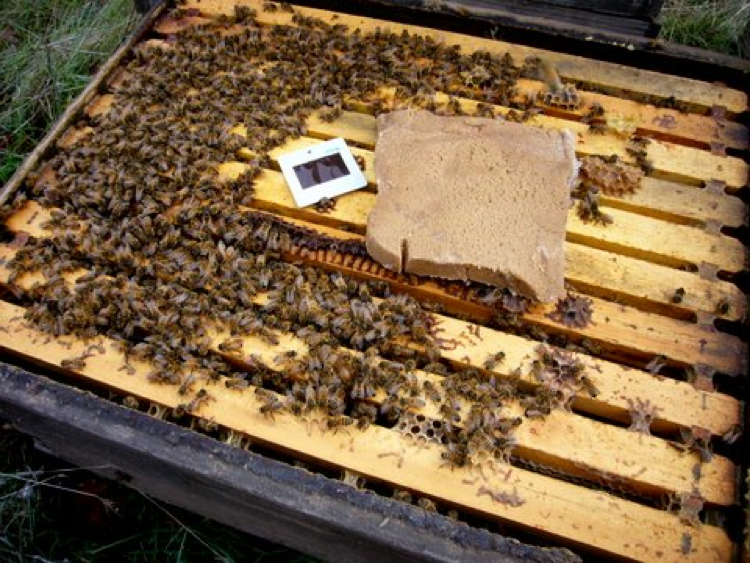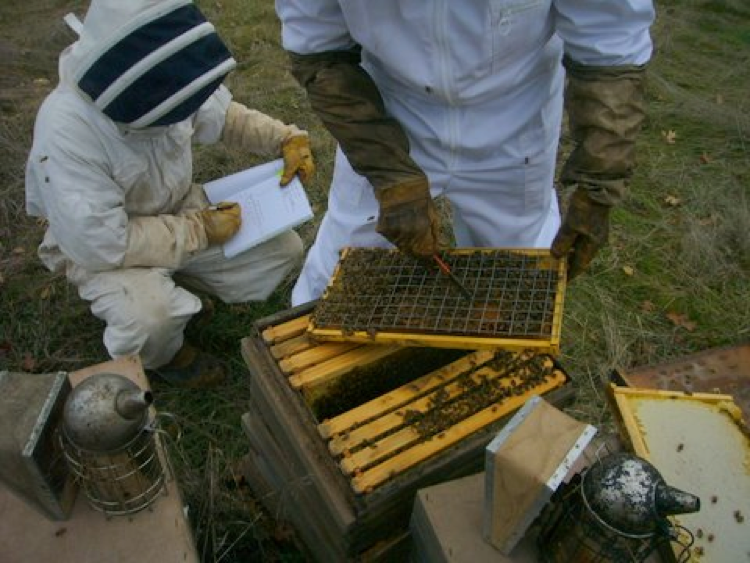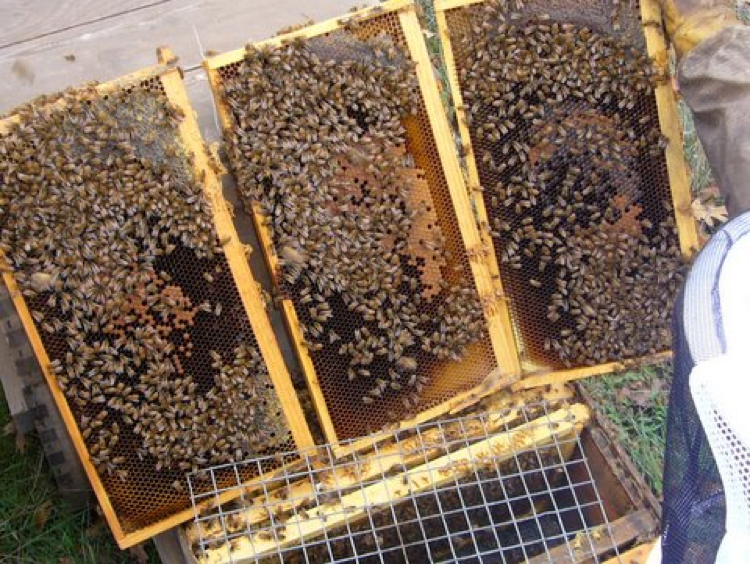A Test of Using Synthetic Pheromones to Initiate Midwinter Broodrearing
Research Note
A Test of Using Synthetic Pheromones to Initiate Midwinter Broodrearing
Randy Oliver
ScientificBeekeeping.com
First published in ABJ July 2010
Objective: to determine if the addition of either ethyl oleate (EO) or synthetic brood pheromone (BP) to colonies prior to the winter solstice would stimulate broodrearing, with the potential practical application towards producing stronger colonies for almond pollination.
Introduction
The signal for honey bee colonies to initiate midwinter broodrearing is poorly understood. It is critical for colonies to begin broodrearing in advance of good flight weather or pollen flows in order to build up to take advantage of early nectar flows. In addition, midwinter broodrearing is necessary to replace bees lost to natural mortality during the winter. Indeed, some colonies may actually increase their population while completely confined in wintering quarters (Harris 2008 and pers comm)!
Although the lengthening of day length after the winter solstice is often cited as the stimulus for the initiation of broodrearing, there is little corroborative evidence that increasing photoperiod is the primary factor, especially since colonies typically initiate broodrearing in late November or early December, at a time when day length is still decreasing (Avitabile 1978 and pers comm; Harris 2008). In fact, colonies will initiate broodrearing even indoors in total darkness!
The winter cluster of bees in cold climates consists almost exclusively of long-lived “winter bees” (Harris 2008), with few bees that could be classified as “foragers.” Thus, there would be little forager production of the primer pheromone ethyl oleate (EO), demonstrated by Leoncini, et al (2004) to have the effect of increasing vitellogenin titers in younger bees. Could it be that aging winter bees transition to “forager” physiology so as to fly out of the hive to die? And in the process could they produce enough EO to induce the remaining cluster to initiate broodrearing to produce more workers to take their places? This hypothesis is supported by observations by Higes (2008) that colonies infected with Nosema ceranae in winter tended to rear more brood, perhaps as a result of a rapidly “aging” workforce due to parasite infection (Tofilski 2009; Gro Amdam, pers comm).
Opportunity presented itself for a “quick and dirty” test of this hypothesis as the winter solstice approached (and almond pollination drew near). Almonds begin blooming about February 15 in California, and beekeepers are paid a premium for strong colonies at that time. Beekeepers routinely attempt to stimulate midwinter broodrearing by artificial feeding of colonies. There would be considerable interest if a synthetic pheromone could be used to induce colonies to ramp up brood production during the month of December.
Materials and Methods
On December 13, 2009, I moved 30 strong, 2-story colonies from a summer yard in Nevada to the Sierra foothills. They were naturally well provisioned with alfalfa honey and rabbitbrush (Chrysothamnus sp.) pollen. The colonies were in winter cluster—any forage had been killed by frost, and temperatures had dropped to near or below freezing each night the previous two weeks.
The following day I made an initial check of 14 randomly chosen colonies–8 contained no brood whatsoever; the rest had had only small patches of sealed brood (it was disruptive to the colonies to do the inspection in cold weather, so I stopped after we confirmed that there was little existing brood). All colonies were then given a 1 lb pollen supplement patty between the boxes, and a pheromone insert adjacent to the patty (Fig. 1), with the active side facing up. I also treated the top box with 50 ml of 3.5% oxalic acid in 1:1 sucrose syrup by dribble between the frames of the upper box (for varroa control). The weather for the duration of the trial was cool and rainy, with highs up to 60°F and lows near or below freezing. There was little flight, and no noticeable natural pollen or nectar flow.
Figure 1. Placement of the pheromone insert and pollen supplement.
The pheromone inserts were specially prepared and donated by Contech Inc. (7572 Progress Way, Delta, British Columbia). Colonies received one of three types of inserts, either ethyl oleate (designed to release 0.4 mg EO per day, roughly equivalent to the total body content of 888,000 foragers (Leoncini 2004) or 63 queens (Keeling 2001); synthetic brood pheromone (SuperBoost®–releasing 0.4 mg per day, equivalent to 660 larval units); or a sham paraffin oil control insert (I was blinded as to type).
After 15 days (December 29) we measured the amount of brood (larvae and sealed) in each colony by the use of a 1 inch wire grid (Fig. 2).
Figure 2. Measuring the amount of brood with a 1-inch wire grid.
Results
There was considerable variation in the amount of brood in the colonies, ranging from 33 to 205 square inches (a full wall-to-wall frame on one side is 128 in2). Although all colonies were not checked for initial amount of brood, it was not surprising that those that did have some brood initially had amounts above the mean at the end of the trial.
Figure 3. Sealed brood present in a colony on December 29, indicating that significant broodrearing took place prior to the winter solstice.
There were no significant differences between treatments (Table 1.).
| Treatment | Number of hives | Mean amount of brood | S.D. |
| Ethyl oleate | 6* | 99.3 | 20.4 |
| SuperBoost brood pheromone | 11* | 92.8 | 29.6 |
| Control | 12 | 101.1 | 61.5 |
| * The different number in this group was an inadvertent result of multiple codings and the blinded researcher running short of strong colonies when we scattered the treatments randomly.
** One colony that proved upon inspection to be very weak was excluded. |
|||
Table 1. Amount of brood per colony after 15 days of treatment with synthetic pheromones beginning prior to the winter solstice.
Discussion
Since there was no apparent difference in the amount of broodrearing due to treatment, the results did not support my hypothesis that winter broodrearing was triggered by production of ethyl oleate by aging bees. Possible factors that could have confounded the results were that the level of EO might have been excessively high (leading to overexposure) or that the horizontal placement of the inserts only allowed contact via the bees’ feet, rather than rubbing against their backs (leading to underexposure).
I also tested the effect of synthetic brood pheromone (which also contains ethyl oleate) concurrently, and found that the application of it too did not appear to affect the initiation of broodrearing immediately prior to the winter solstice. This result helps to clarify the temporal window in which the use of synthetic brood pheromone may have practical application, as other studies have shown benefit from its use at other times of the year (Pankiw, et al 2008; Moeri, et al, in prep).
Note that this was only a small trial, and I wouldn’t presume it to be definitive. The results with synthetic pheromone applications are variable. Due to the great economical importance of strong colonies for almond pollination, further midwinter trials of synthetic pheromone stimulation would certainly be warranted.
Acknowledgements
I wish to thank Drs. John Borden and Cameron Lait of Contech for their assistance, and Contech for the donation of the inserts and for funding the trial. I also express my gratitude to my son Ian Oliver for his assistance in the field work.
References
Avitabile, A (1978) Brood rearing in honey bee colonies from late autumn to early spring. Journal of Apicultural Research 17: 69–73.
Harris, JL (2008) Effect of requeening on fall populations of honey bees on the northern Great Plains of North America. Journal of Apicultural Research and Bee World 47(4): 271–280.
Higes, M, et al (2008) How natural infection by Nosema ceranae causes honeybee colony collapse. Environmental Microbiology 10(10): 2659–2669.
Keeling, CI, 2001. Isolation and identification of new components of the honey bee (Apis mellifera) queen retinue pheromone. PhD Dissertation, Simon Fraser University, Vancouver.
Leoncini, I, Y Le Conte, G Costagliola, E Plettner, AL Toth, M Wang,Z Huang, J-M Bécard, D Crauser, KN Slessor, and GERobinson (2004) Regulation of behavioral maturation by a primer pheromone produced by adult worker honey bees. Proc Natl Acad Sci USA 101: 17559-17564.
Moeri, OE, CG Lait, E Kovacs, and JH Borden (in prep) SuperBoost: synthetic brood pheromone for revitalization of overwintered honey bee colonies. Submitted to J. Apic. Res.
Pankiw, T, RR Sagili, and BN Metz (2008) Brood pheromone effects on colony protein supplement consumption and growth in the honey bee (Hymenoptera: Apidae) in a Subtropical Winter Climate. J. Econ. Entomol. 101(6): 1749-1755.
Tofilski, A (2009) Shorter-lived workers start foraging earlier. Insect. Soc. 56(4): 359-366.






